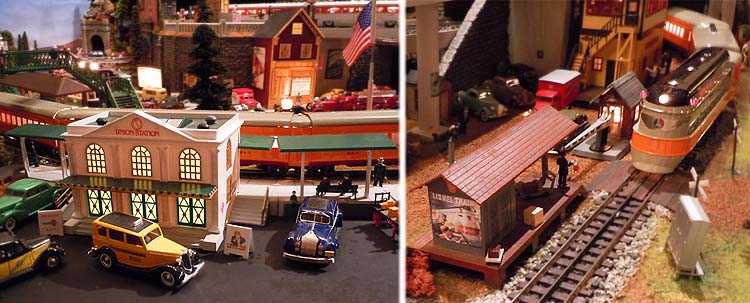|
|
Information Booth:
Frequently Asked Questions About Model Train Layouts
I didn't put this website up to become the Dear Abby of toy trains. Nevertheless, people found this site and kept asking me questions. I'm far from an expert in this hobby - I simply learned enough to build my model railroad layout. Because of the press of my work and other activities, I can't answer your individual questions. But here are answers to the ten most popular ones people ask: 1. I want to build a layout. Where do I start? There are four major steps to take before you begin construction:
2. Will you ever publish the plans for your layout? Nope. And you don't want my plans anyway. Design your own to suit your taste and requirements. But, if you want some idea-generating layout photos to look at, here they are:
3. What's the best layout for kids? Kids love layouts with tunnels. They like to see the trains disappear then re-appear. Kids also like animations - flashing crossing signals, a gateman who jumps out of his shack when the train goes by, operating crossing gates, bubbling tubes in oil pumping accessories and the like.
Children also like steam locomotives - they enjoy seeing the drivers go around on the wheels and they want to hear the whistle. And see the smoke. It's amazing to me that all children love dinosaurs and steam engines. Both are long extinct, so kids can't relate to the real thing. But they love them anyway. Hey! There's an idea - put some dinosaurs on your layout - behind a fence in the 'Extinct Zoo.' Your children will love it. By the way, anything that kids love will delight adults, too. After all, we're all kids at heart. 4. I want to start with one set. What should I buy? I'd buy one of MTH's Ready-To-Run O-gauge Rail King starter sets. They come with a train and cars, a transformer and a circle of track, so they're ready to go right out of the box - although you'll probably want to buy some additional straight pieces of track. These MTH sets are quite sturdy and a great value. Most hobby shops carry MTH trains. In 2000, I bought the Pennsylvania Express starter set - a Pennsylvania 2-8-0 Consolidation steam locomotive and tender, a box car, hopper car and caboose. The whole thing cost $159.00 - a bargain. (If you want it with Protosound, which produces a realistic steam-chuffing sound and an upgraded digital whistle sound, you'll pay $50-$100 more.)
The nice thing about freight trains is that you can easily add more cars - you're not trying to match an existing car design (as is often the case with passenger sets). MTH's track has molded-in roadbed, so if any lubricant drips from the engine, it falls on the roadbed - not your carpet. MTH and Lionel are competitors - they are the two largest manufacturers of O gauge trains. Both produce top-of-the-line, $1,000+ engines and the quality of their high-end products is reportedly pretty close. But in the lower-priced, entry-level arena, MTH's Rail King line has quality which is far superior (in my opinion) to Lionel. I've had some bad experiences with Lionel-made products. Originally, my grandson's train set ran in an oval beneath the Christmas tree. Or in his playroom. Later, as a six year-old, he got his own simple, kid-friendly layout - one level on a single sheet of 4x8 plywood. It features two train loops and a point-to-point track for his reversing trolley car. And a tunnel, crossing flashers, a flashing billboard and a rotating beacon. All buildings are internally lit and there are street lights so it looks good at night. 5. Where's the best place to buy trains? For new stuff, your choices are - mail order (includes internet - almost all mail order firms have websites) or the local hobby shop. I buy from both. Generally, mail order suppliers have better prices (unless the hobby shop is having a sale). But, with mail order, you can't see and touch what you're buying - and mail-order firms aren't usually geared to providing a lot of tech help and advice. Hobby shops let you see, touch and run the merchandise before you buy and the good ones run how-to-workshops to help their customers. Visit several in your area to find a good one that suits your needs. I've had good experiences with the fine folks at Whistle Stop Trains in Portland, Oregon. For used stuff, you can attend model railroad swap meets or buy from private parties. Or eBay. I have friends who regularly buy cars and trains on eBay - new and used. But I'm not an auction-kinda-guy, so I can offer no guidance. Caveat emptor. 6. I have some old trains. How much are they worth? Beats me. I'm not in the business of buying or selling trains. 7. Are 'O-gauge' and 'O-scale' the same thing? To most lay people, they are. 'O' denotes 1/48th scale. O gauge uses 3-rail track and the track is not-quite-to-scale - it sits a little higher than scale. Why? Because O-gauge rail cars and trains have wheels with large flanges to prevent derailments when some kid is flinging the trains around curves at 120 mph scale speed. Some O-gauge train sets also have shorter-than-scale engines and cars so that they can easily go around tight curves. People, like me, who use three-rail O gauge track but try to create a realistic-looking layout are known in the hobby as "high railers." On the other hand, O scale people are purists - they use two-rail track of a properly-scaled height, the cars are scale length, their layouts have wide, realistic curves, etc. There are other differences, too. If you're interested in the specifics, ask at your hobby shop. Or read model train publications. O-gauge is far more popular than O scale - by almost 100-fold. And, since most lay people use 'O scale' when they mean 'O gauge' and since 'O scale' is the far more popular search term on search engines, I use the term 'O-scale' liberally throughout this site, even though my layout is technically 'O-gauge.' Are you confused enough yet? 8. How do you build mountains and scenery? I bought several do-it-yourself books from hobby shops and read them thoroughly. I carefully followed the directions and the photos on this site show the results. Scenic Express is a firm offering some excellent scenery and layout accessories. (Look for the ads and order the catalog - it's full of great stuff.) One of the things which makes mountains look good is realistic coloring. I used color photos from travel books as a guide when painting and detailing my foam mountain. 9. Where do you get buildings? And cars? All of the buildings on my model railroad are from kits or ready-mades advertised in hobby magazines. A wide variety of buildings and structures are available for every scale. Walthers makes good kits; MTH sells some nice fully assembled structures. Both are reasonably priced. Then there's Bachmann's legendary Plasticville USA which offers low-cost structures which, with a little detailing (see Tips page), can really look great. Many of Plasticville's designs date back to the early 1950s. On the lower level of my layout, the Union Station and freight station/gatehouse set are both Plasticville:
The vehicles on my layout are from my own collection; I've been collecting 1:43 scale model cars for over 50 years. Many of the cars on my layout are out-of-production models and, therefore, are hard-to-find; however, there are lots of scale diecasts available from numerous suppliers. In recent years, I've probably purchased more model cars and trucks online from Diecast Direct and American Excellence than anywhere else. Both firms are honest and reliable. 10. This all seems very hard. Isn't there an easier way? There's always an easier way. For those of you who have lots of money and not enough time or ambition, there are professionals who will build a museum-quality layout and then, deliver and install it in your home, garage or office. These fine craftsmen are easily found - they advertise in all of the hobby publications. Prices range from $10,000 to $100,000+. In its 2009 holiday catalog, Hammacher Schlemmer offered 'The Genuine Lionel Store Display Diorama', a simple 4x8 platform with figure-eight layout and one basic train set for a whopping $12,000. Shipping extra. For those who have the courage and fortitude to 'do it yourself', I am happy to offer ten tips to make your model railroad better-looking and more professional - click here. 11. Any Other Thoughts? Thanks for asking. Twenty years after I built this layout, I reflected on it here. PS: I have no ties to any of the companies I've recommended here and have received no compensation from them. I'm simply a customer who has been pleased with service I've received. All of the firms listed here have websites - you can find them using a good search engine. I hope this information is helpful.
|
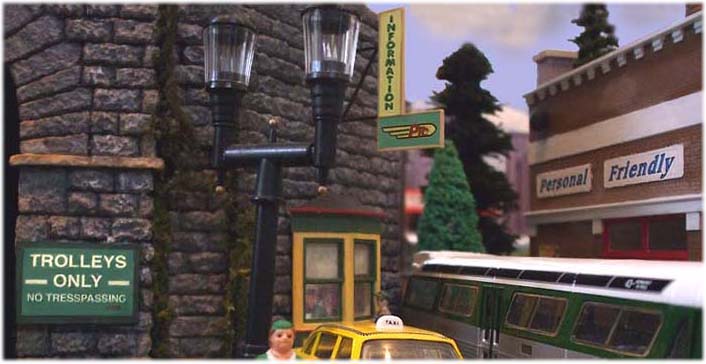
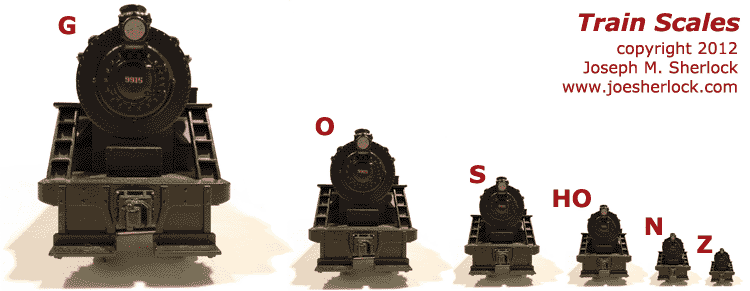
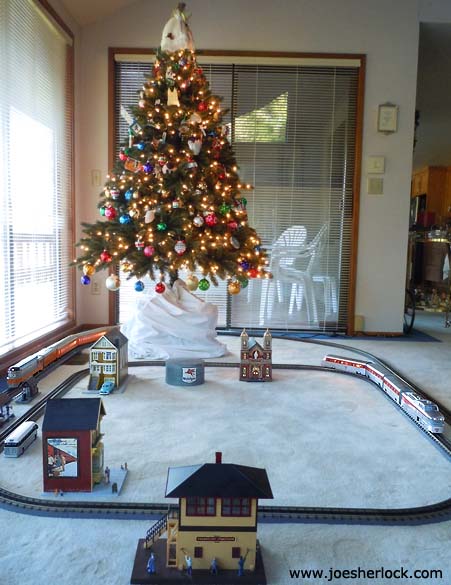
 They like operating freight cars, too - log dumpers, animated box cars, etc. (Kids aren't nearly as impressed by switches and sidings as adults are.) Kids like to watch trains go around in the dark, too. So light your buildings and make sure you have a lighted caboose on freights and at least one passenger set with illuminated cars.
They like operating freight cars, too - log dumpers, animated box cars, etc. (Kids aren't nearly as impressed by switches and sidings as adults are.) Kids like to watch trains go around in the dark, too. So light your buildings and make sure you have a lighted caboose on freights and at least one passenger set with illuminated cars.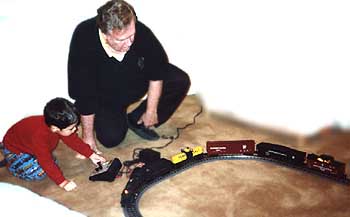 In the photo, my grandson and I are playing with his Christmas present - the Pennsylvania Express set. Notice that he's running the trains, even though he was under four years-old at the time.
In the photo, my grandson and I are playing with his Christmas present - the Pennsylvania Express set. Notice that he's running the trains, even though he was under four years-old at the time.